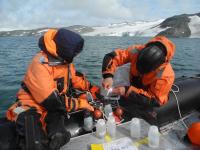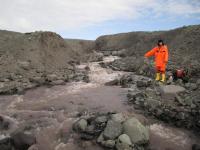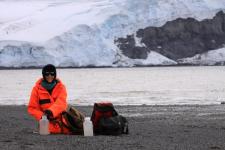Sediment traps and other obstacles
About one and a half months ago, Jöran and I (Sanja) started our trip to Antarctica. Everything went different than planned. Actually we should have arrived at Antarctica before New Year’s Eve, but the Argentinean logistics thwarted our plans.
We had to wait for about 3 weeks at the military airport of Rio Gallegos before we could organize another flight to Antarctica by the Chilean commercial airline DAP. Coming to King George Island, we were very lucky that the Argentinean military ship "Castillo" had just arrived in the local waters and could pick us up. So we finally arrived at Jubany on the 12th of January. For me it was a feeling of coming home (because I had been able to spend two and a half month here in the past), for Jöran pure fascination. But the bad luck was on our heels and therefore we had to deal with many problems in the beginning. During winter there had been a longer cut in electricity of the Dallmann which probably caused a frost damage of the pure water plant. For this reason we had to wait until Susann arrived, because she brought almost a whole lab and with that - a Millipore plant! In between we could go for a first sampling trip along the coastline of Potter Peninsula. One of our tasks here is to analyze the water of the glacial meltwater streams for nutrients and suspended sediments to calculate the input of these into the cove. So, at low tide we take samples of four of these streams and back in the lab we have to do a lot of filtration work and then analyze the nutrients via photometric methods. Unfortunately, just after finishing the preparations for our first nutrient measurement, bad luck struck again. We had to learn that our micro titer plate reader only produced error messages. It was broken, unrepairable under these conditions. Thankfully, we could once again rely on the comprehensive lab equipment of Susann, who also brought a photometer. After a few changes in our methods and with a lot of borrowed materials we could finally start measuring.
 Preparing the sediment traps on board of the Zodiac |
 Sanja is showing the sampling point - a glacial meltwater stream |
 Sanja is measuring pH and Salinity of a water sample |
Another point of our campaign is to install sediment traps at two locations in the cove and recover the settled sediments once per week. Of course, here we had to struggle with some problems as well. Bad weather conditions, no physician available in case of a diving accident, the search for weights which would keep the sediment traps at their place, this all delayed the installation for 8 days. But with the help of the well-trained Argentinean divers we could finally manage this as well. To complete our sampling strategy, once a week we also go out by boat and sample the water column of the inner and outer cove at different locations in different depths. The success of this work depends a lot on the weather conditions. For example, our first sampling trip had to be aborted after 4 of the planned 6 stations because the waves on the outer cove were too high. On the other hand, our second trip was pure beauty. The whole area was nearly windless, the sun was shining in the beginning and no problems occurred until the Niskin bottle wouldn't close any more for our last sample. Meanwhile, the weather had freshened up a little and while Jöran and our CTD-man Ale were trying to fix the bottle it started snowing. After half an hour of try and error we could manage to get our last sample. When we came back into the cove we could see that the wind had blown small and big chunks of ice from the glacier in the direction of Jubany station. Antarctica definitely knows how to make up for all the troubles it causes.

